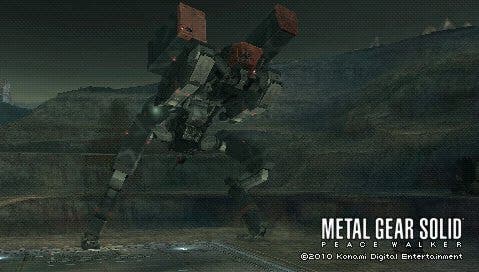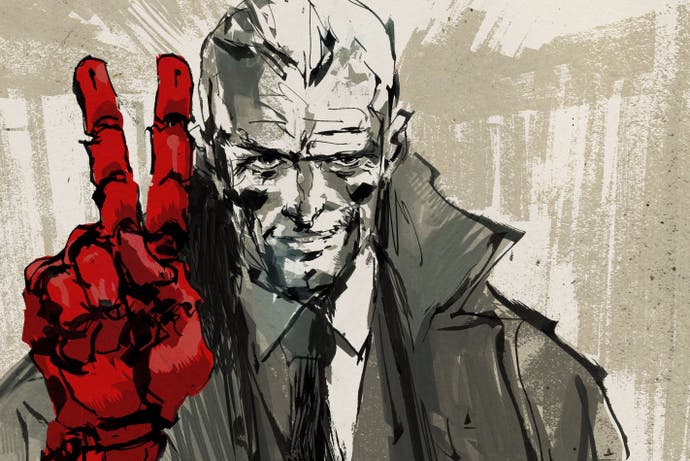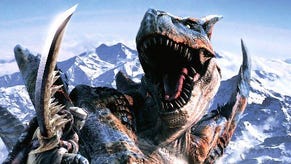Metal Gear Solid: Peace Walker - Portable perfection
¡°Peace won't just come to us. We are going to have to meet it halfway.¡±
For most of Peace Walker's development, and even in early US promotional material, this 2010 PSP title had a grander designation - Metal Gear Solid 5: Peace Walker. The absence of a number on the final product can be put down to a hundred things: simple rejection of a 'main' entry being a portable title; the PSP itself entering its final years; perhaps a concern that series fans would revolt at the radical departure from Metal Gear Solid 4. Whatever it was, that number's existence says one thing about Kojima Productions' mindset with Peace Walker. This is no spin-off.
It was, however, the culmination of several spin-offs - the Metal Gear Acids and Portable Ops - that had given Kojima Productions great expertise with the PSP hardware. Those games were good, but hadn't hit the heights of the mainline series. "The concept itself was created probably right after we released Metal Gear Solid: Portable Ops," Hideo Kojima told Eurogamer. "I thought I would pass it on to the younger staff in Kojima Productions." In a central theme of Metal Gear Solid's development history, Kojima instead ended up directing, producing and writing Peace Walker.
The director has offered various reasons for this, one especially gnomic offering being that the younger staff did not fully understand the Cold War setting. But I'd wager two facts matter more than others. The first is that Peace Walker represented Kojima Production's last chance to make a smash-hit on PSP, hardware that the studio had invested heavily in. It is no accident that Capcom's Monster Hunter series, a PSP sales sensation in Japan, is the major influence on Peace Walker's design. The second is that Kojima himself, following the overindulgent Metal Gear Solid 4, was energised by the idea of designing a new experience within much stricter technical limitations.

The defining aspect of Peace Walker is that it's the one Metal Gear Solid where Kojima could not depend on the crutches of FMV cutscenes, state-of-the-art visuals, and endless mid-mission codec sequences. He'd been bitten by the portable bug, and understood that this platform required completely different design priorities.
"I played Pokemon Gold/Silver with my son," Kojima told Famitsu "Until I played it, I didn't understand at all what was so interesting about it, so I wasn't very excited at first. Actually playing it, though, was a huge surprise. It was like, I had no idea there was such a great game out there! I wound up finishing it twice, I was so addicted. I think Peace Walker works something like that. If you just look at the visuals, it's not as amazing as a PS3 or Xbox 360 game, but you can't 'get it' unless you play it."
Pokemon is perhaps the exemplar of handheld design, yet ever since the originals detractors have commented unfavourably on the way it looks or 'fails' to innovate - never seeing the wood for the trees. Pokemon is a grand adventure that feels intimate and personal, one that can shrink-to-fit millions of different players. Ever since the Game Boy Nintendo's designers have understood that portable design is not about squeezing console games onto a tiny screen - Sony's biggest strategic flaw with handhelds - but creating small windows onto bigger worlds.
A forceful way to make the point that portable titles are not inferior, just different, would be to develop Metal Gear Solid 5 for a portable console. To this end Peace Walker stands as the most radical game in the Metal Gear series, not your average lineage anyway, by breaking away completely from the basic structure established by the original Metal Gear Solid.
Metal Gear Solid and the three numbered sequels morphed to their own ends, but all are fundamentally linear stealth games where you start at A and end up at B. This formula reached a point of no return in Metal Gear Solid 4, which has some of the most incredibly-detailed environment work you'll ever see. You'll only see them for a few seconds, though; the thread pulling the player onwards is powerful, but the expectations of a PS3 showcase meant that Kojima Productions spent huge amounts of time creating locations the player would visit once and never see again.
It's clear Kojima understood this through the simple fact he never made another Metal Gear Solid game in the original style after Guns of the Patriots. Peace Walker represents this break, both enabled by the lower expectations of the target platform and - what is now clear in hindsight - acting as a dry-run for what would become The Phantom Pain.

But we're getting ahead of ourselves. Peace Walker keeps the Metal Gear Solid stealth system at its core, pulling back from the more 'realistic' guards of Snake Eater and Guns of the Patriots towards reduced sight ranges and less complex offensive behaviours. The biggest change is that you now undertake missions with set criteria across different areas, later revisiting the same territory for different reasons, and each of these missions is self-contained. The principle play of Metal Gear Solid is intact but now yoked to an overarching structure rather than a linear narrative - enter Mother Base.
One of Kojima's skills as a director is being able to link a game's systems (and thus the player's actions) to wider thematic points. While in Mother Base you are building Militaires sans Frontieres ('Soldiers Without Borders'), Big Boss's own nuclear-capable army. Ultimately a series of beautifully-produced menus, the base-building side of Peace Walker ties-in so well because it acts as kind of a processing unit. The player collects resources in the missions, in the form of soldiers and items, through which Mother Base gets better and develops more cool gadgets for use.
It's a reciprocal arrangement even if, on this first try, Kojima Productions didn't get it quite perfect. Options are included to streamline the process, automatically assigning soldiers to suitable units - so then why would anyone spend time doing it manually? Your GMP overfloweth, meaning R&D is just an options menu, and there's no risk of 'failing' at managing the base. Despite this the feeling of growing your army and capabilities over time, of gaining staff and sending them out on combat missions, becomes a huge part of the appeal - perhaps because endgame goals like building your own Metal Gear are much more involved.
The other side to this arrangement, one of the reasons Mother Base always feels worthwhile, is a mechanic so good it changed the course of the series - the Fulton surface-to-air recovery system. Based on a real CIA device to lift VIPs out of danger zones, here the idea of a balloon whisking people away solved a problem that Metal Gear already had. Portable Ops now looks like a prototype for Peace Walker and not least in the kidnapping idea, whereby the player would knock out guards and then drag them back to the level's start, where they'd become part of your unit. But dragging bodies around is a drag, and one of Portable Ops' stronger ideas was ruined as a result.
The fulton replaces this with an instant risk/reward that, even if it's ridiculous, is funny and practical enough to indulge. Attaching a Fulton to a downed enemy sees a balloon appear above them which, after a few seconds, drags them into the sky screaming. Needless to say this can alert nearby soldiers to your presence, and they can even shoot down balloons, creating a choice when you're taking on a group - do you take everyone out silently then fulton, and risk someone waking up, or extract your latest victims asap and risk raising the alarm? Not to mention how well it incentivises taking out enemies non-lethally, in a series that has always fretted about its enjoyment of casual killing.

Through this brilliant addition Metal Gear Solid's stealth system acquires a new dimension and, in the way environments begin to be re-used, a new confidence. When you've finished Peace Walker's main story, which takes place across different environments, the game continues and begins re-mixing the enemies and in some cases the layouts - in the knowledge it's now dealing with experienced and kitted-out players. The remaining story content is sparse, the focus instead shifting to missions and boss fights, and there are so many it feels like it'll never end. Peace Walker contains by far the most straight-up game content of any Metal Gear Solid before it: a sizeable campaign, ongoing epilogue, side-ops, boss battles, and then all the base-building and endgame loot-collecting.
All this and we've barely touched on the most brilliant part of Peace Walker's concept, which is its unique take on co-op. At the outset it's important to clarify that this means two people in the same room on two PSPs - that's the ideal situation Peace Walker was designed for, though it has boss battles allowing for four players. This is the Monster Hunter influence, because a large part of that game's popularity on PSP was ascribed to it being played together in both public and private. There is an enormous difference between this co-op situation and online play, not least the ease of communication and the natural bond that already exists between the players. It's the latter point in particular that Peace Walker aims to tap into.
The whole of Peace Walker is playable in co-op and, over time, you notice how efficiently it enables the experience. The 'Snake-in' command, whereby one player can attach to another in order to switch their focus back to the real world for a second, is one of those features that may seem pointless but after a few hours you realise is inspired. The rotating circles around each player's feet, which expand as you get closer and blend into one big circle when close enough, are an exceptional piece of visual communication - showing position, reinforcing 'close' team-play, and instantly-readable. The levels are filled with little shortcuts and sniping spots that only a team of two can reach. And in battle you've got your buddy's back, capable of sharing ammo and items or even delivering CPR. At the core of Peace Walker's concept is the idea of playing with friends in the same room, and it delivers spectacularly.
So we return to Monster Hunter, a game so important to Peace Walker that part of the endgame content is actually Monster Hunter - an officially-licensed handful of hunts against iconic Capcom beasties, with various Metal Gear Solid-styled nods to that great series. Never before or since has Kojima been so explicitly inspired by another team's work and, it is interesting to note, Peace Walker's few failings often come from his lifting something without fully understanding it.
Kojima and his team managed to replicate MH's feeling of camaraderie with other players, but their attempt to emulate the peerless endgame that would keep them playing together fell rather more flat. In Monster Hunter the endgame, where you grind-out better gear as the monsters become even-more terrifying, makes a lot of sense and works because hunting the monsters is always great - and your abilities as a player are always the most important thing.
Peace Walker's equivalent bosses are military vehicles and, to put it simply, they don't scale nearly as well. They are fun to fight, the first couple of times, but for the late-game their damage and health is scaled extraordinarily in order to face-off against four players. This is a series with quite beautiful and precise control schemes, but the combat bears no comparison to Monster Hunter because the focus in MGS is stealth. So when Peace Walker tries to create an endgame of bosses like Monster Hunter does, the basic fights aren't interesting enough to bear the weight - and the damage scaling makes them a slog.
With flaws like this, as you look closer, you can see the bones of something else. Take the streamlining of Mother Base functions, for example, which suggests a more hardcore sim approach was initially in-place but then sacrificed for a 'smoother' experience - perhaps one not so alienating to traditional MGS players. The circuit boards for Metal Gear Zeke, a main endgame collectable, are so numerous but linked to such repetitive battles that you feel - even in such an enormous game - some part we'll never know about is simply missing. The competitive online mode, in contrast to the co-op, was barebones.
The game that Peace Walker would prove the template for, Metal Gear Solid 5: The Phantom Pain, has since launch been dogged by a similar sense that it's incomplete. Each game is a staggering achievement and perhaps that's why relatively minor flaws seem bigger. Peace Walker was the necessary halfway step between the design of Guns of the Patriots and The Phantom Pain, and laid the foundations for one of 2015's greatest experiences: the mission-based structure; the integration of Mother Base; the side-ops; the fultons; even, one could argue, the buddy system.
Not bad for a 2010 PSP game but then, that fact is why Peace Walker is so good. This is the Metal Gear Solid game where we can see most clearly Kojima's talents as a pure game designer - building situations, setting up encounters, and slotting everything into a larger structure. The relative restrictions, after spending years on PS3, somehow forced the absolute best out of him in a way that the linear narratives - with their set-pieces and lengthy non-interactive sequences - did more to stymie. There are other contenders but, for me, Peace Walker is the best game that the PSP ever had.






